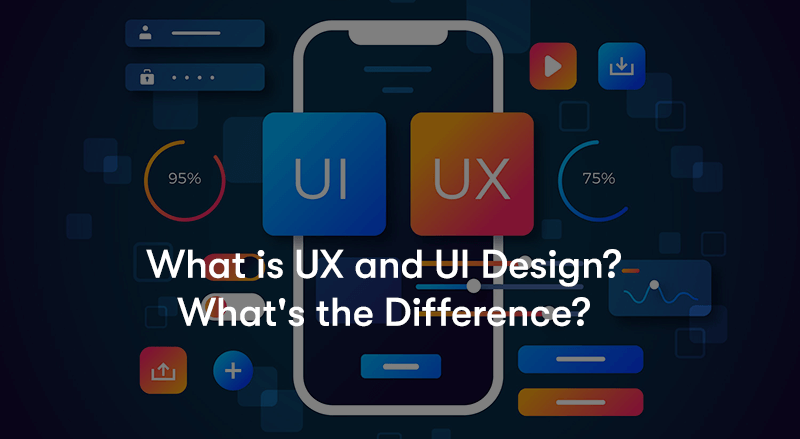What is UX and UI Design? What's the Difference?
In today's digital age, understanding these critical design disciplines is essential for anyone creating user-friendly and visually appealing digital products. In this blog, we will delve deep into the worlds of User Experience (UX) and User Interface (UI) design, exploring their unique roles, responsibilities, and how they work harmoniously together.
Whether you're a budding designer, a curious enthusiast, or a business owner looking to enhance your product's success, this guide will provide valuable insights into these essential aspects of modern design.
What is UI Design?
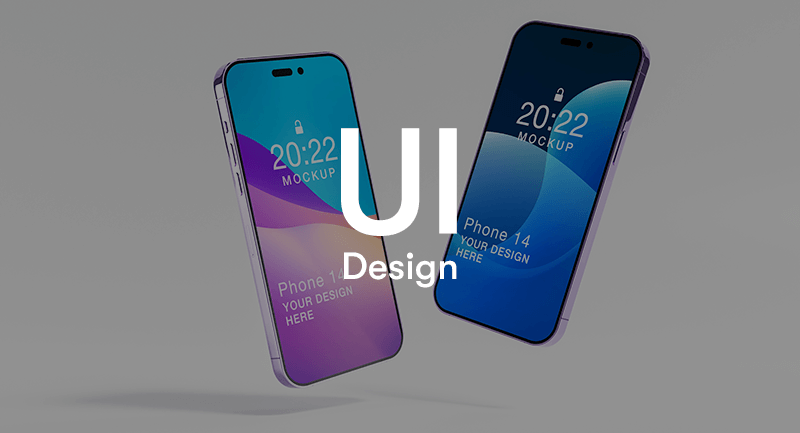
UI Design, which stands for User Interface Design, is a field of design focused on creating the visual and interactive elements of a user interface for digital products and applications. UI designers work to ensure that the interface of a website, mobile app, software program, or any other digital platform is visually appealing, user-friendly, and intuitive for users to navigate and interact with. Here are some key aspects of UI design:
Visual Design
UI designers are responsible for the aesthetics of the interface. This includes choosing colour schemes, typography, icons, images, and overall layout to create a visually appealing and cohesive design.
Layout
Designers determine how elements are arranged on the screen to ensure that the content is organised and user-friendly. This includes creating wireframes and prototypes to plan the layout before the final design.
Interactive Elements
UI designers design buttons, menus, forms, and other interactive components with which users can click, tap, or interact. They need to ensure these elements are easy to understand and use.
User Experience Integration
While UI design focuses on the visual and interactive aspects, it closely collaborates with User Experience (UX) design. UX design considers the overall user journey, information architecture, and usability, while UI design brings these concepts to life through the interface.
Consistency
Consistency is crucial in UI design to make the user experience seamless. Designers create a set of design guidelines or a design system to maintain consistency in elements like buttons, fonts, colours, and spacing throughout the interface.
Responsive Design
UI designers often need to ensure the interface is responsive to different screen sizes and devices, such as smartphones, tablets, and desktop computers. This involves adapting the layout and design to fit various screen dimensions.
Accessibility
Designing with accessibility in mind is important to ensure that the interface is usable by individuals with disabilities. This includes considerations for screen readers, keyboard navigation, and colour contrast.
Testing and Iteration
UI designers often conduct usability testing and gather feedback to refine the interface. They make iterative improvements based on user feedback to enhance the overall user experience.
UI design is a crucial part of the software and product development process, as it directly impacts how users perceive and interact with a digital product. A well-designed user interface can enhance user satisfaction, engagement, and usability, contributing to the product's success in the market.
What is UX Design?
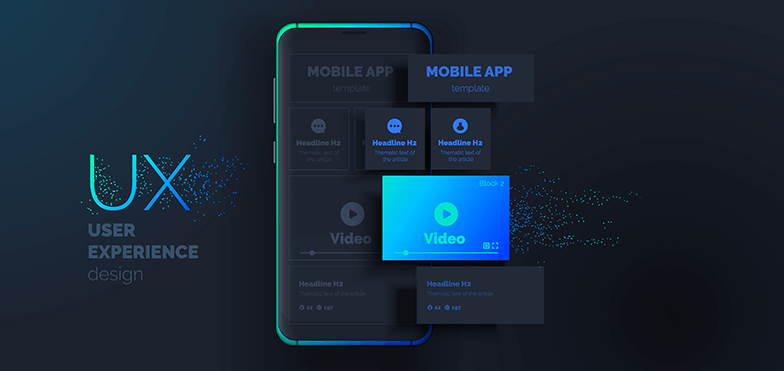
UX Design, or User Experience Design, is a multidisciplinary field that focuses on creating meaningful and enjoyable user experiences when interacting with digital products, websites, apps, or physical systems. UX designers aim to understand users' needs, behaviours, and preferences and use that knowledge to design products that are easy to use, efficient, and satisfying. Here are some key aspects of UX design:
User Research
UX designers conduct extensive user research to gain insights into the target audience. This research may involve surveys, interviews, observations, and user testing to understand user goals, pain points, and behaviours.
Information Architecture
Designers organise the content and structure of a product to ensure that users can easily find the information they need. This involves creating sitemaps and defining the hierarchy of information.
Interaction Design
Interaction designers focus on defining how users will interact with a product. They design the user flows, navigation, and interactive elements to make the user journey smooth and intuitive.
Prototyping
Creating prototypes allows designers to visualise and test their ideas before the final product is developed. Prototypes can range from low-fidelity sketches to high-fidelity interactive simulations.
Usability Testing
UX designers often conduct usability testing to gather user feedback and identify usability issues. This iterative process helps refine the design based on real user experiences.
Accessibility
Ensuring the product is accessible to users with disabilities is a key aspect of UX design. Designers consider screen reader compatibility, keyboard navigation, and colour contrast.
Visual Design
While UX design primarily focuses on the user's overall experience, it also involves aspects of visual design to create an aesthetically pleasing and cohesive interface. However, the visual design is distinct from UI design, which focuses exclusively on the visual and interactive elements.
Empathy
UX designers cultivate empathy for users by putting themselves in the users' shoes and advocating for the user's needs and interests throughout the design process.
Iteration and Continuous Improvement
UX design is an iterative process. Designers continually gather feedback and improve the product to enhance the user experience over time.
Collaboration
UX designers often work closely with other team members, including UI designers, developers, product managers, and stakeholders, to ensure the design aligns with the project's goals and constraints.
The ultimate goal of UX design is to create products that are not only functional but also delightful to use. A positive user experience can lead to increased user satisfaction, loyalty, and the success of a product or service in the marketplace. UX design is an integral part of the product development process and plays a crucial role in shaping the overall perception of a brand or product.
What's the Difference Between UX and UI Design?
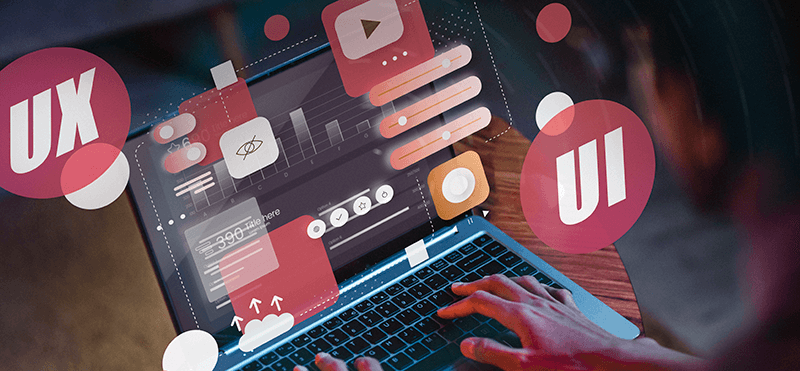
UX design and UI design are two distinct but closely related disciplines in the field of digital product design. While they overlap and complement each other, they have different focuses and responsibilities:
Focus and Purpose
UX Design: UX design primarily concerns the overall user experience and how users interact with a product. It focuses on understanding user needs, behaviours, and pain points to create a useful, efficient, and enjoyable product. The goal is to ensure that the product meets user goals and provides a positive experience.
UI Design: on the other hand, UI design is specifically focused on the visual and interactive elements of the product's interface. It deals with the aesthetics, layout, and presentation of elements to make the product visually appealing and user-friendly. UI designers ensure the product's interface looks good and is easy to navigate.
Responsibilities
UX Design: UX designers are responsible for conducting user research, creating user personas, defining information architecture, designing user flows, and crafting wireframes and prototypes. They work to understand the user's journey and ensure that the product meets their needs and expectations.
UI Design: UI designers take the wireframes and prototypes created by UX designers and focus on the visual design aspects. They choose colours, typography, icons, buttons, and other graphical elements to create a cohesive and aesthetically pleasing interface. UI designers also work on creating interactive features that users can click, tap, or interact with.
Output
UX Design: The output of UX design includes user personas, user journeys, wireframes, prototypes, and usability testing reports. UX designers prioritise the overall functionality and usability of the product.
UI Design: The output of UI design includes visual style guides, design mock-ups, and interactive prototypes. UI designers prioritise the visual appeal and user interface elements.
Collaboration
UX Design: UX designers collaborate closely with stakeholders, researchers, product managers, and UI designers to ensure that the product aligns with user needs and business goals.
UI Design: UI designers collaborate with UX designers to bring the visual aspects of the interface to life and maintain a consistent visual style throughout the product.
Timeline
UX Design: UX design typically occurs earlier in the product development process, focusing on research, user testing, and the overall concept. It informs the foundation of the product's design.
UI Design: UI design usually follows UX design and comes into play once the structure and user flows have been established. It focuses on the detailed look and feel of the interface.
In summary, while UX and UI design are related and often work together closely, they have distinct roles within the design process. UX design prioritises the overall user experience and functionality, while UI design focuses on the visual and interactive aspects of the interface. Both are essential for creating successful and user-friendly digital products.
What Does a UI Designer Do?
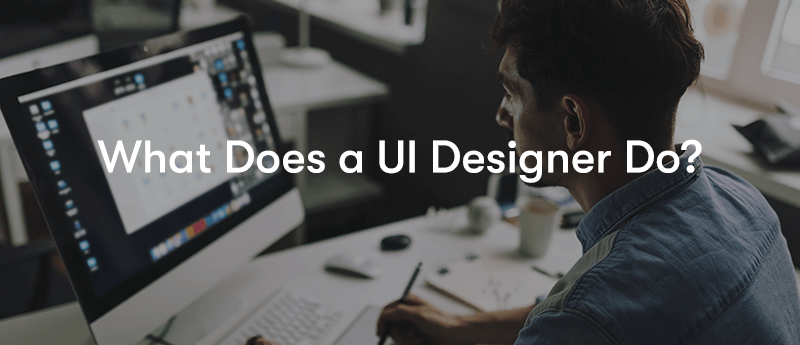
A UI designer is responsible for creating the visual and interactive elements of a digital product's interface, such as a website, mobile app, software application, or any other user-facing digital platform. The primary goal of a UI designer is to ensure that the interface is aesthetically pleasing, user-friendly, and effectively communicates the product's functionality to users. Here are the key responsibilities and tasks of a UI designer:
Visual Design
UI designers are responsible for the overall visual design of the interface. This includes:
- Selecting colour schemes that are visually appealing and align with the product's branding.
- Choosing appropriate typography (fonts) for text elements, headers, and other content.
- Creating or selecting icons, images, and graphics that enhance the visual appeal and convey information effectively.
Layout Design
Designers plan and organise the layout of the interface to ensure that information is presented in a clear and organised manner. This involves:
- Arranging elements such as buttons, menus, forms, and content blocks to create a balanced and visually pleasing composition.
- Ensuring consistency in spacing, alignment, and proportions throughout the interface.
Interactive Element Design
UI designers design interactive elements with which users can click, tap, or interact. This includes:
- Creating buttons, checkboxes, radio buttons, sliders, and other interactive controls.
- Designing user interface animations, transitions, and feedback mechanisms to enhance the user experience.
Responsive Design
Ensuring that the interface is responsive and adapts to various screen sizes and devices (e.g., smartphones, tablets, desktops) is critical to UI design. Designers must consider how elements reflow and adapt to different screen dimensions.
Prototyping
UI designers often create interactive prototypes or mock-ups of the interface to visualise the design and demonstrate how it will function. Prototyping helps in the early testing and validation of design concepts.
User Feedback Integration
UI designers collaborate with UX designers to incorporate user feedback and insights into the interface's design. They make adjustments and improvements based on user testing and usability studies.
Accessibility
UI designers ensure the interface is accessible to all users, including those with disabilities. This involves adhering to accessibility guidelines and principles, such as providing image text alternatives and ensuring proper colour contrast.
Design Consistency
Maintaining design consistency is crucial to creating a cohesive user experience. UI designers often develop and document design guidelines or systems to ensure consistency across the entire product.
Collaboration
UI designers work closely with other team members, such as UX designers, developers, product managers, and stakeholders, to align the visual design with the project's goals and user requirements.
Keeping Up with Trends
UI designers stay informed about the latest design trends, tools, and technologies to ensure their designs remain current and competitive.
Overall, a UI designer plays a pivotal role in shaping how users interact with and perceive a digital product, aiming to create visually appealing, intuitive, and effective interfaces conveying information and functionality.
What Does a UX Designer Do?
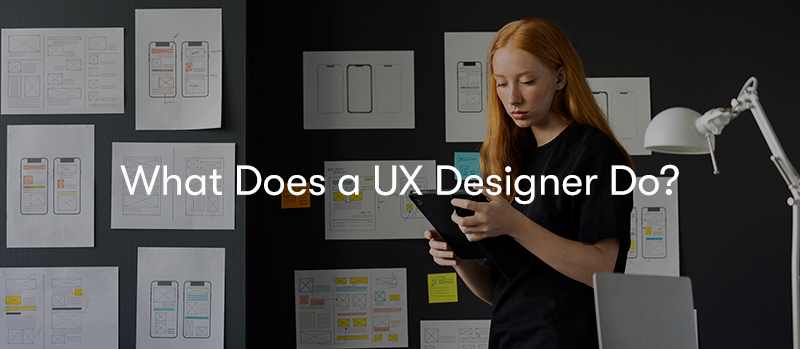
A UX designer is responsible for creating and enhancing the overall user experience of a digital product, such as a website, mobile app, software application, or any other user-facing system. The primary goal of a UX designer is to ensure that the product is easy to use, efficient, enjoyable, and aligns with the needs and goals of its users. Here are the key responsibilities and tasks of a UX designer:
User Research
Conduct user research to gain a deep understanding of the target audience. This may involve surveys, interviews, observations, and usability testing to uncover user needs, behaviours, preferences, and pain points.
User Personas
Create user personas, fictional representations of different user types or segments. Personas help the design team empathise with users and make user-centred decisions.
Information Architecture
Define the product's information architecture, which involves organising and structuring content to make it easy for users to find what they need. This often includes creating sitemaps and defining content hierarchies.
User Flows
Design user flows or journeys that outline how users will navigate the product to accomplish their tasks. This helps ensure a logical and efficient user experience.
Wireframing and Prototyping
Create wireframes (low-fidelity sketches) and prototypes (interactive mock-ups) to visualise the product's layout and functionality. Prototypes are often used for user testing and iteration.
Usability Testing
Conduct usability tests with real users to gather feedback on the product's usability. UX designers analyse the test results to identify usability issues and areas for improvement.
Interaction Design
Define how users will interact with the product. This includes designing the user interface's interactive elements, such as buttons, menus, forms, and navigation.
Accessibility
Ensure that the product is accessible to users with disabilities. UX designers consider factors such as screen reader compatibility, keyboard navigation, and adherence to accessibility guidelines.
Content Strategy
Collaborate with content creators to develop a content strategy that aligns with the user's needs and the product's goals. This includes creating user-friendly and engaging content.
Collaboration
Work closely with UI designers to ensure that the visual design aligns with the user experience and that the interface is consistent with the user's expectations.
Iterative Design
Embrace an iterative design process, continually refining and improving the product based on user feedback and evolving requirements.
Advocate for Users
Act as an advocate for the user's needs and interests throughout the design and development process, ensuring that the user remains at the centre of decision-making.
Stakeholder Communication
Communicate design concepts and rationale to stakeholders, including product managers, developers, and executives, to gain buy-in and support for design decisions.
Stay Informed
Stay updated on industry trends, best practices, and emerging technologies to incorporate relevant design innovations into the user experience.
In summary, a UX designer's role is to create a user-centred design that delivers a seamless, efficient, and enjoyable user experience. UX designers combine user research, information architecture, interaction design, and usability testing to create products that meet user needs and business objectives. Their work contributes significantly to the success and user satisfaction of digital products.
Can UX and UI Design Work Together?

Yes, UX and UI design can and should work together closely in the design process to create successful digital products. While these two disciplines have distinct focuses and responsibilities, they are highly complementary, and collaboration between UX and UI designers is crucial for delivering an exceptional user experience. Here's how they can work together effectively:
Shared Goals
Both UX and UI designers aim to create user-friendly and visually appealing digital products. They aim to ensure that the product is functional, aesthetically pleasing, and satisfying to use.
Collaborative Process
UX and UI designers should collaborate from the early stages of a project. UX designers typically lay the groundwork by conducting user research, creating personas, and defining user journeys. UI designers then use this information to craft the visual and interactive elements of the interface.
Iterative Approach
The design process is iterative, and feedback flows between UX and UI designers. UX designers may use prototypes to test user flows and gather insights, and UI designers use this feedback to refine the visual design.
Consistency
UI designers ensure that the visual design aligns with the user experience and that there is consistency in the use of colours, typography, icons, and other design elements. This consistency is essential for a seamless user experience.
User-Centred Design
UX and UI designers should always keep the user at the centre of their design decisions. UX designers focus on understanding user needs and behaviours, while UI designers translate this understanding into a visually appealing and user-friendly interface.
Usability Testing
UX designers often conduct usability testing to gather feedback from users. UI designers can use this feedback to make design adjustments related to the visual and interactive aspects of the interface.
Communication
Effective communication between UX and UI designers is vital. They must share insights, design concepts, and user feedback to ensure that the design aligns with user needs and the project's goals.
Empathy
Both UX and UI designers should cultivate empathy for users, striving to understand their perspectives, frustrations, and goals. This shared empathy helps create a cohesive and user-focused design.
Adaptation
As the project progresses, UX and UI designers may need to adapt their designs based on changing requirements, user feedback, or evolving business objectives. Close collaboration enables them to make these adjustments smoothly.
Design Handoff
When the design is ready for implementation, there should be a clear and well-documented design handoff from UX to UI designers. This ensures that the visual design aligns with the user experience and that developers have the necessary design assets and guidance.
In summary, UX and UI design are complementary disciplines that work together to create digital products that are not only functional but also aesthetically pleasing and user-friendly. Collaboration between these two roles is essential for achieving a cohesive and successful user experience. When UX and UI designers work together effectively, they can deliver products that meet user needs and business objectives.
Salary for UX vs UI - Which Pays Better?

The salary for UX and UI designers can vary depending on several factors, including location, experience, industry, and the specific company or organisation. Both UX and UI designers can earn competitive salaries, but there are some general trends to consider:
Location
Salaries for UX and UI designers can vary significantly based on geographic location. Designers working in significant tech hubs or cities with a high cost of living, such as San Francisco, New York, or London, tend to earn higher salaries than those in smaller cities or regions with a lower cost of living.
Experience
Experienced designers typically command higher salaries. Entry-level or junior designers may earn less than their more experienced counterparts. As designers gain more years of experience and a proven track record, their earning potential increases.
Industry
The industry in which a UX or UI designer works can influence salary levels. For example, designers in industries like finance, healthcare, or e-commerce may earn higher salaries compared to those in non-profit organisations or start-ups.
Company Size
The size and financial stability of the company or organisation can also impact salaries. Larger corporations or established companies often offer more competitive compensation packages than smaller start-ups or agencies.
Skills and Specialisation
Designers with specialised skills or expertise in user research, interaction design, or accessibility may command higher salaries due to their in-demand skills.
Education
While a formal education in design (such as a bachelor's or master's degree) can be beneficial, it is not always a strict requirement. However, having a relevant degree or certification in UX or UI design can potentially lead to higher-paying opportunities.
In general, there is yet to be a definitive answer as to whether UX or UI designers earn more, as it varies based on individual circumstances and the factors mentioned above. Both roles are critical in designing and developing digital products, and they often work together closely.
To determine which role might pay better for a specific situation, individuals should consider their location, experience, skills, and the demand for their expertise in the job market. Additionally, conducting salary research within their specific region and industry can provide more accurate insights into the earning potential for UX and UI designers in their area.
Are UX and UI Design Good Careers to Get Into?

Yes, both UX design and UI design can be excellent and rewarding career choices for individuals with the right skills, interests, and aspirations. Here are some reasons why UX and UI design can be promising careers to get into:
High Demand
As technology continues to play an increasingly central role in our lives, the demand for skilled UX and UI designers is rising. Companies across various industries recognise the importance of creating user-friendly and visually appealing digital products, leading to a strong demand for design professionals.
Competitive Salaries
UX and UI designers can earn competitive salaries, especially as they gain experience and expertise. Salaries vary by location and experience level, but experienced designers enjoy above-average compensation.
Job Opportunities
The job market for UX and UI designers is diverse. You can find opportunities in technology companies, startups, design agencies, e-commerce, healthcare, finance, and many other industries. This diversity allows you to explore various domains and industries based on your interests.
Creative and Problem-Solving Work
UX and UI designers have the opportunity to work on creative projects that involve problem-solving. You'll be tasked with making digital products more user-friendly, efficient, and visually appealing, which can be intellectually stimulating and rewarding.
Impactful Work
Effective UX and UI design can significantly impact users' experiences and a company's success. You can make a meaningful difference by creating products that improve people's lives and meet their needs.
Continuous Learning
The field of UX and UI design is dynamic and constantly evolving. This means that you'll have opportunities for ongoing learning and skill development, keeping your work fresh and exciting.
Collaboration
UX and UI designers often collaborate with cross-functional teams, including developers, product managers, marketers, and researchers. This collaborative aspect of the role can enrich and provide exposure to various aspects of the product development process.
Remote Work Opportunities
Many UX and UI design roles offer the flexibility to work remotely, allowing for a better work-life balance and the ability to work from anywhere with an internet connection.
Career Advancement
With experience and expertise, UX and UI designers can advance in their careers and take on leadership roles, such as UX/UI design lead, design manager, or even Chief Design Officer (CDO) positions.
To succeed in these careers, developing strong design skills, staying updated on industry trends, and continuously refining your portfolio is essential. Additionally, cultivating skills in user research, usability testing, and collaboration will further enhance your career prospects.
Ultimately, whether UX or UI design is the right career choice depends on your interests, strengths, and career goals. Both fields offer opportunities for creative expression, problem-solving, and making a meaningful impact on the digital world.
Where Can You Learn More About UX Design?
Our BCS Foundation Certificate in User Experience training course is perfect for anyone who wants to increase their knowledge of User Experience. The BCS User Experience course will teach you the UX methodology, best practices, techniques, and a strategy for creating a successful user experience. The course will cover the following topics:
- Guiding Principles.
- User Research.
- Illustrating The Context of Use.
- Measuring Usability.
- Information Architecture.
- Interaction Design.
- Visual Design.
- User Interface Prototyping.
- Usability Evaluation.
Click the button below to find out more.

Final Notes on UX and UI Design
In conclusion, User Experience and User Interface design offer promising career opportunities in today's digital-centric world. With high demand, competitive salaries, and the chance to make a meaningful impact on user experiences, these design disciplines provide a fulfilling path for creative problem solvers.
Whether you're drawn to enhancing functionality and usability (UX) or crafting visually appealing interfaces (UI), the choice ultimately aligns with your interests and career goals. Both paths offer a dynamic, ever-evolving landscape where continuous learning and collaboration are valued. So, if you're considering a career in design, UX and UI are excellent choices worth exploring.


